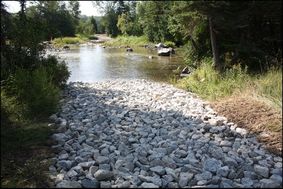Manitou River - M65

Channel Rehabilitation
Site M-65 is a site where extensive erosion and scouring of the stream bed habitat had occurred over the past century due to previous poor land use practices and log drives. In addition to this fluctuating and low water levels decreased the depth of the water in this wide section of the river. In order to rehabilitate this site, bio-engineered site design methods concentrated on restoring the proper bank width, which in turn accomplished two goals of the strategy in reducing river width and increasing river depth. A large excavator mounted hydraulic rock hammer created pools in the soft limestone, constrictors such as “W” weirs and wing deflectors were installed to narrow overall width and thereby increasing the rivers depth and provide in stream cover. Large boulders were strategically placed to positively utilize water flows and to create more in-stream aquatic habitat. A designated vehicle crossing, a ford, was enhanced to prevent erosion at entry and exit points.
The rehabilitation of site M65 involved the installation of the following fish habitat features along an approximately 170m long section of the Manitou River: seven (7) boulder clusters, one (1) “W” Weir, five (5) pools excavated into bedrock, two (2) ramps associated with an existing ford, four (4) single wing deflectors, prepare and implement an erosion and sediment control plan. 48.76 m of split cedar rail fencing installed to restrict livestock.
A total of 7590 m2 of in stream habitat was rehabilitated. This project had 7 volunteers from the Board of Directors of Manitoulin Streams participate in planning and actively volunteering at rehabilitation sites. The total number of hours volunteered for this site is 51.4 hours. Six 6 volunteer fence builders put in a total of 12 hours.
The landowner contributed 32 hrs of labour and 7 hrs of attending meetings and the in-kind support included supplying materials, boulders, rocks, and fencing.
Site M-65 is a site where extensive erosion and scouring of the stream bed habitat had occurred over the past century due to previous poor land use practices and log drives. In addition to this fluctuating and low water levels decreased the depth of the water in this wide section of the river. In order to rehabilitate this site, bio-engineered site design methods concentrated on restoring the proper bank width, which in turn accomplished two goals of the strategy in reducing river width and increasing river depth. A large excavator mounted hydraulic rock hammer created pools in the soft limestone, constrictors such as “W” weirs and wing deflectors were installed to narrow overall width and thereby increasing the rivers depth and provide in stream cover. Large boulders were strategically placed to positively utilize water flows and to create more in-stream aquatic habitat. A designated vehicle crossing, a ford, was enhanced to prevent erosion at entry and exit points.
The rehabilitation of site M65 involved the installation of the following fish habitat features along an approximately 170m long section of the Manitou River: seven (7) boulder clusters, one (1) “W” Weir, five (5) pools excavated into bedrock, two (2) ramps associated with an existing ford, four (4) single wing deflectors, prepare and implement an erosion and sediment control plan. 48.76 m of split cedar rail fencing installed to restrict livestock.
A total of 7590 m2 of in stream habitat was rehabilitated. This project had 7 volunteers from the Board of Directors of Manitoulin Streams participate in planning and actively volunteering at rehabilitation sites. The total number of hours volunteered for this site is 51.4 hours. Six 6 volunteer fence builders put in a total of 12 hours.
The landowner contributed 32 hrs of labour and 7 hrs of attending meetings and the in-kind support included supplying materials, boulders, rocks, and fencing.

